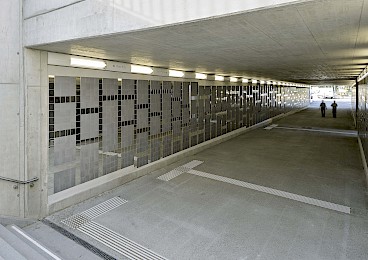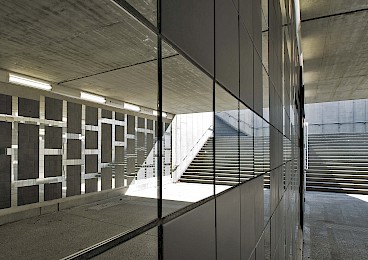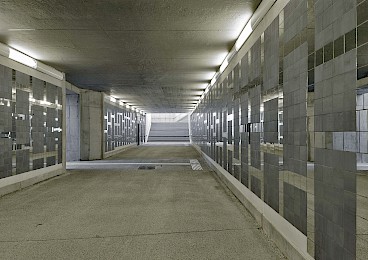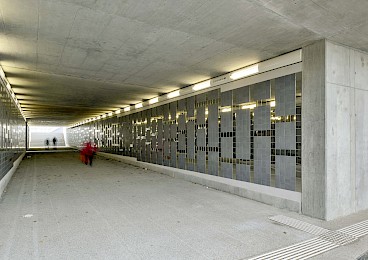Since the 1990s the photos, sculptures and installations by the artist Gerold Tagwerker have been reflecting the form and content aspects of modern architectures that have decisively influenced the development and changes of the urban area for the last 50 years, ist conditions of perception and the associated transformation processes in urban life.
Viewers facing Tagwerker's works find themselves not in a passive attitude of contemplation. Rather they become active protagonists — they inscribe themselves in the work and update it. This becomes paticularly evident in Tagwerker’s works for the public space. Never do they “just” reflect the specific urban building and architectural features of the location. They also constantly deal with its tradition and its function as a field of agitation of cultural and socio-political debate.
Thus here, too: in cooperation with Anna Wickenhauser, the architect, Tagwerker designed a horizontal grid band of gray ceramic tiles on the walls of the pedestrian underpass at Landstraser Gurtel/ Adolf-Blamauer-Gasse and Ghegastrase. Intermittent lengthwise and crossways mirror tiles give it an ornamental rhythm. Through the multiple refractions of light and color, the contrast between matte ceramic tiles and reflecting mirror tiles seems to open the underpass transversally on both sides. Through a horizontal band of lighting, the pedestrian underpass also acquires a longitudinally oriented dynamic. The natural light from the outside surroundings is shifted into the architectural interior and interweaves the dimensions of inside and outside — between above-ground public city space and subterranean passageway space. The underpass becomes the aesthetic scope of action with an interplay between natural and artificial light, between nearby and distant space.
On walking through, the passersby are confronted with a continuum of possible views: the mirror images of themselves and the others are constituted into an indissoluble interweaving of small snapshots of color and details. Thus the observers simultaneously become protagonists, directors and spectators of a constantly changing, time-based — almost filmic — perception. The subjective, fast-cut “mental cinema” that develops through the personal speed of movement only terminates after the “end of the performance” on passing the light-filled screens at the exit from the underpass, on plunging into the urban reality.
In his work Tagwerker draws on found industrially manufactured materials such as neon tubes, mirror glass, tiles or galvanized grills in order to explore fields of meaning such as light, rhythm, grids, perspective and perception — also inspired by Minimal Art. In contrast to the minimalists, who were striving for objectivity, depersonalization, non-composition and non-relation, and rejected any subjective involvement, Tagwerker consciously relates to forms whose architectural references and charging with cultural history he is constantly reflecting on. With Tagwerker, the perception theory of the neutral subject of observation too, almost dogmatically pursued by the representatives of Minimal Art, is replaced by the idea that neither forms nor their visual representations and their reception are free from socio-cultural conventions and aspects.
Text: Fiona Liewehr
Location
underpass at Landstraßer Gürtel/Adolf-Blamauer-Gasse and Ghegastrase, 1030 Vienna
Gallery
Further Information
Artist
Gerold Tagwerker
*1965 in Feldkirch (AT), lives and works in Vienna
geroldtagwerker.com
This project was selected as a winner's project in the course of an artistic competition. For more information please follow this link:
Time Period
Since September 18, 2012
ceramic / mirror tiles
52 x 2,7 m





